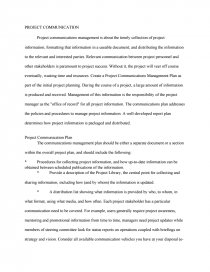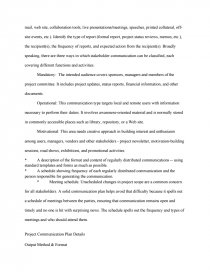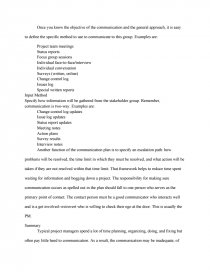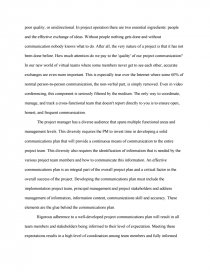Project Communication
Essay by jocottle • January 18, 2013 • Essay • 1,122 Words (5 Pages) • 2,018 Views
PROJECT COMMUNICATION
Project communications management is about the timely collection of project information; formatting that information in a useable document; and distributing the information to the relevant and interested parties. Relevant communication between project personnel and other stakeholders is paramount to project success. Without it, the project will veer off course eventually, wasting time and resources. Create a Project Communications Management Plan as part of the initial project planning. During the course of a project, a large amount of information is produced and received. Management of this information is the responsibility of the project manager as the "office of record" for all project information. The communications plan addresses the policies and procedures to manage project information. A well-developed report plan determines how project information is packaged and distributed.
Project Communication Plan
The communications management plan should be either a separate document or a section within the overall project plan, and should include the following:
* Procedures for collecting project information, and how up-to-date information can be obtained between scheduled publications of the information.
* Provide a description of the Project Library, the central point for collecting and sharing information, including how (and by whom) the information is updated.
* A distribution list showing what information is provided by who, to whom, in what format, using what media, and how often. Each project stakeholder has a particular communication need to be covered. For example, users generally require project awareness, mentoring and promotional information from time to time, managers need project updates while members of steering committee look for status reports on operations coupled with briefings on strategy and vision. Consider all available communication vehicles you have at your disposal (e-mail, web site, collaboration tools, live presentations/meetings, speeches, printed collateral, off-site events, etc.). Identify the type of report (formal report, project status reviews, memos, etc.), the recipient(s), the frequency of reports, and expected action from the recipient(s). Broadly speaking, there are three ways in which stakeholder communication can be classified, each covering different functions and activities.
Mandatory: The intended audience covers sponsors, managers and members of the project committee. It includes project updates, status reports, financial information, and other documents.
Operational: This communication type targets local and remote users with information necessary to perform their duties. It involves awareness-oriented material and is normally stored in commonly accessible places such as library, repository, or a Web site.
Motivational: This area needs creative approach in building interest and enthusiasm among users, managers, vendors and other stakeholders - project newsletter, motivation-building sessions, road shows, exhibitions, and promotional activities.
* A description of the format and content of regularly distributed communications -- using standard templates and forms as much as possible.
* A schedule showing frequency of each regularly distributed communication and the person responsible for generating the communication.
* Meeting schedule. Unscheduled changes in project scope are a common concern for all stakeholders. A solid communication plan helps avoid that difficulty because it spells out a schedule of meetings between the parties, ensuring that communication remains open and timely and no one is hit with surprising news. The schedule spells out the frequency and types of meetings and who should attend them.
Project Communication Plan Details
Output Method & Format
Once you know the objective of the communication and the general approach, it is easy to define the specific method to use to communicate to this group. Examples are:
...
...




